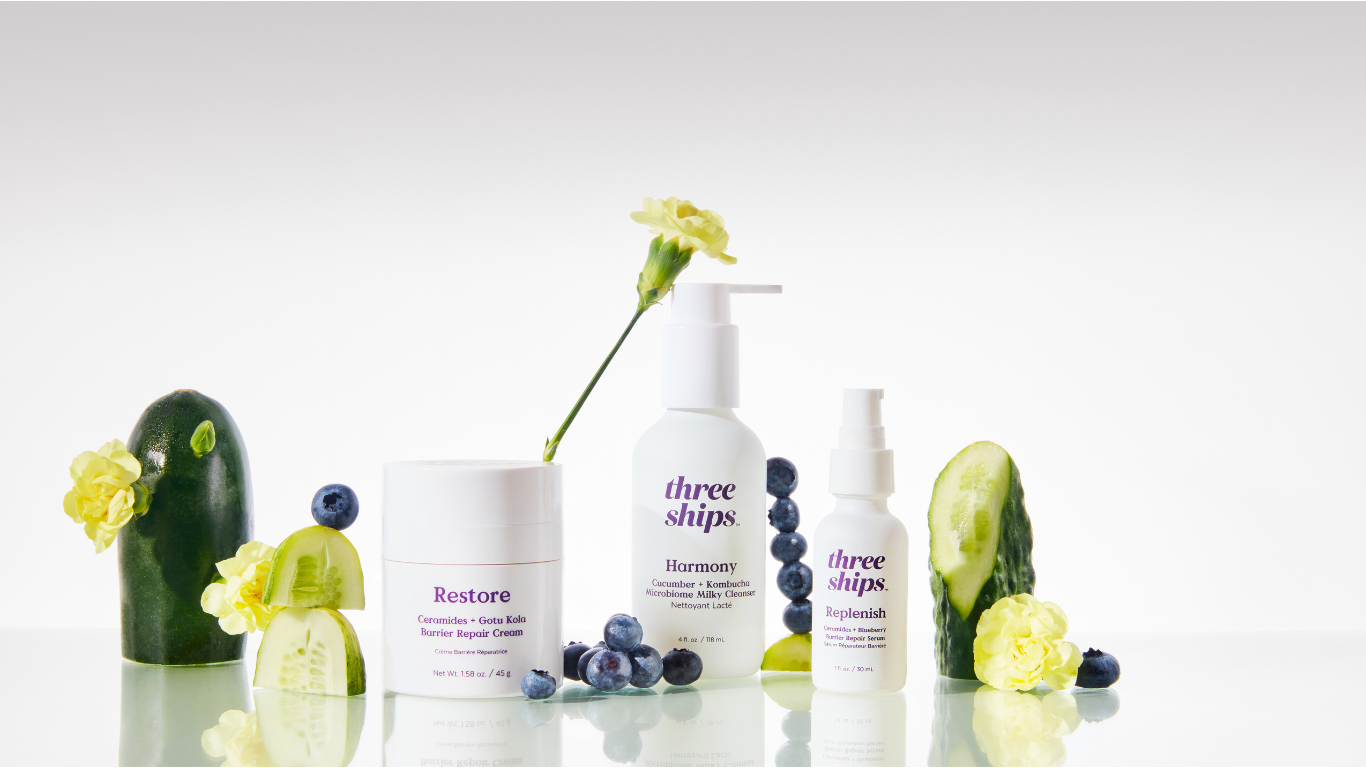How To Combine Salicylic Acid and Vitamin C in Your Skincare Routine

It isn’t just skincare products that are confusing — their ingredients are confusing, too. We get it.
At Three Ships Beauty, we’re cutting through the confusion and helping you understand which ingredients work, and which ingredients you actually need.
Two natural ingredients we’re helping you decode: salicylic acid and vitamin C.
Touted for its unmatched acne-fighting action, salicylic acid is a heavy hitter in many oil-banishing products. We’ll cover what it is and how much you actually need. We’ll also talk about how vitamin C went from OJ to an OG skincare ingredient that helps protect and brighten your skin.
These two ingredients are powerfully effective, but combining them can be tricky. Let’s unpack everything you need to know about how to combine salicylic acid and vitamin C in your skincare routine.
What Should I Know About Combining Ingredients?
Just like oil and water don’t mix, some skincare ingredients don’t blend well. While the benefits of salicylic acid and vitamin C are both important, using them together takes a little finesse.
Know Your Skin Type
Skin type is important and largely responsible for helping you choose the right products and ingredients for your skin. The American Academy of Dermatology recognizes four different skin types:
- Dry. Skin that feels tight, stretchy, itchy, and possibly flakes.
- Oily. Oily skin often feels greasy, appears shiny, and is blemish-prone.
- Normal. Skin is neither excessively oily nor dry, but feels smooth and comfortable to the touch.
- Combination. Skin is dry in some areas, oily in others (especially the t-zone).
It’s important to recognize that very few people have a true “normal” skin type. Most of us have some form of combination skin, with areas that are oily and other areas (like the cheeks) that are often drier.
If you aren’t sure of your skin type, try this test: Wash your face with a mild cleanser and pat dry. Don’t apply any products to your skin, and wait thirty minutes. Next, feel your skin. If it’s tight and uncomfortable, you likely have dry skin. If you can wipe excess oil away with a tissue, your skin is more oily. If you only have oil in your t-zone, you probably have combination skin.
Know Your Skin Concerns
From acne to eczema, skin disorders and conditions are extremely common, affecting at least one in four people. Because different ingredients work for different conditions, it’s important to use the right ingredient to target your specific skin concern.
Salicylic acid, for instance, is great for acne-prone skin, while vitamin C can help brighten and fade scars. There are more benefits to each, but we’ll talk about those later.
What Are the Basics of Salicylic Acid?
It’s virtually impossible to have a pimple without someone tossing a salicylic acid product your way, and there’s a reason why: it works.
Salicylic acid is a beta-hydroxy acid that is naturally occurring in plants and vegetables. It’s lipophilic or fat-soluble, which means it dissolves in fatty lipids. This is why it works so well on blemishes.
- Sebum (the skin’s natural oil that gets trapped in pores and creates blemishes) is mostly made of fat. Because salicylic acid attracts and dissolves into oil, it can better target problematic areas where too much oil is collected, break it up, and carry it out of your pores.
- It’s powerful but not drying. Acne solutions can leave your skin dry and irritated, but salicylic acid, in small percentages, helps eliminate bumps without eliminating your skin’s natural moisture.
At Three Ships Beauty, we find that less is often more, especially when it comes to salicylic acid. Salicylic acid is a natural exfoliant, which makes it perfect for blemishes, eliminating dead skin cell buildup and supporting healthy skin cells. However, too much can cause irritation.
While some products have as much as 5% salicylic acid, we find that more skin types can benefit from less. Using less still battles blemishes without leaving you red-faced, irritated, and itchy.
What Are the Basics of Vitamin C?
Everyone is familiar with vitamin C, but aside from knowing “it’s good for you,” most of us aren’t sure what exactly it does for our skin.
It’s An Antioxidant
By now, we all know we need antioxidants, but here’s the reason why. Our skin is constantly under attack from free radicals. Free radicals are unbalanced molecules that are constantly searching for other healthy, balanced molecules. When they find these molecules, they rob them of an electron and damage them.
For your skin, this means that healthy molecules that make up your skin cells get damaged, sometimes beyond repair. Free radical damage appears as fine lines, wrinkles, skin sagging, and even dark areas of hyperpigmentation.
Free radicals are everywhere. Common sources are:
- Ultraviolet rays from the sun
- Cigarette smoke
- Pollution (like smog)
- Industrial cleaning chemicals
Antioxidants, like vitamin C, work as a shield. They defend your skin cells against free radicals by offering up an electron, allowing the free radical to become balanced, and protecting the molecules in your skin cells from losing their electrons and experiencing damage.
It Supports Youthful Skin
Collagen is a protein that helps your skin stay plump, firm, and looking youthful. As we age, we naturally lose collagen. Statistics show we lose about 1% of collagen each year after age 20. To maintain youthful-looking skin even when collagen dips, it’s vitamin C to the rescue!
Vitamin C is a necessary component of skin elasticity, and adding it to your skincare routine can help you maintain supple, youthful-looking skin.
Both salicylic acid and vitamin C are essential skincare ingredients, but adding them together at the same time each day might not be the best way to deliver their benefits.
How Can I Combine Salicylic Acid and Vitamin C?
Combining salicylic acid and Vitamin C can help with your skin concerns, but using these two ingredients together can potentially throw off your skin’s pH balance.
Your Skin’s pH Balance
Your skin has a pH balance that is usually a little acidic. This helps prevent the overgrowth of bad bacteria on your skin, like the kinds that can mix with sebum and create a pimple.
If your skin becomes too alkaline, it may feel dry and even begin to flake. If it becomes too acidic, that can be problematic, too.
Because both vitamin C and salicylic acid can affect the pH balance of your skin, it’s important to use them in formulas that contain safe levels of each ingredient to maintain the perfect balance of the uppermost layer of your skin where blemishes and skin problems can happen.
Tips for Using Ingredients Together
Anytime you combine two ingredients that might not work well together, there are a few simple rules to help ensure you get effective results without irritation.
- Use the products at different times during the day. For instance, using vitamin C in the morning helps protect your skin against free radical damage, and salicylic acid in the evening can help give your skin the ingredients it needs to heal and restore overnight.
- Try different days. If you’re using a specialized treatment (like a mask), use it on a different day so that you aren’t at risk of combining ingredients at the same time.
- Use the ingredients together…with the right products. It is possible to use both salicylic acid and vitamin C on the same day at the same time if you’re using products intended to work together synergistically.
At Three Ships Beauty, we did the work, so you don’t have to. We made it easy for you to get the benefits of salicylic acid and vitamin C in products that play well together and don’t require a master’s level education to decipher how to use.
Better Together
Wrinkles and pimples? You aren’t alone. We created products to help combat both at the same time. It’s as easy as a cleanser, serum, and an occasional mask.
- Refresh Papaya + Salicylic Acid Cleanser. The perfect cleanser does exist. A combination of salicylic acid sourced from aspen bark and vitamin C help keep your skin clarified and bright. The perfect amounts of each ensure that you won’t experience irritation or dryness when used daily.
- Dew Drops Mushroom Hyaluronic Acid + Vitamin C Serum. Level up your hydration and supercharge your vitamin C intake with the ease of a highly effective serum. Kakadu plum contains 100 times more vitamin C than oranges, getting 100 times the brightening power.
- Soothe Rosehip Vitamin C Clay Mask. Self-care is the best care. Gentle French pink clay helps loosen dirt deep in your pores and clean out impurities, while rosehip packs powerful vitamin C to help smooth out the appearance of fine lines and wrinkles.
Combine Forces for Better Skin
Three Ships Beauty helps you find the skincare naturals that work. Ingredients can be overwhelming, but when you learn to use them safely and effectively, you’ll be on the right track to radiant, glowing skin.
Sources:
Determining Your Skin Type | AAD.com
Free Radicals and Extrinsic Skin Aging | PMC
- Tags: rec1:refresh-papaya-salicylic-acid-cleanser rec2:dew-drops-mushroom-hyaluronic-acid-vitamin-c-serum Skin Education
0 comments





